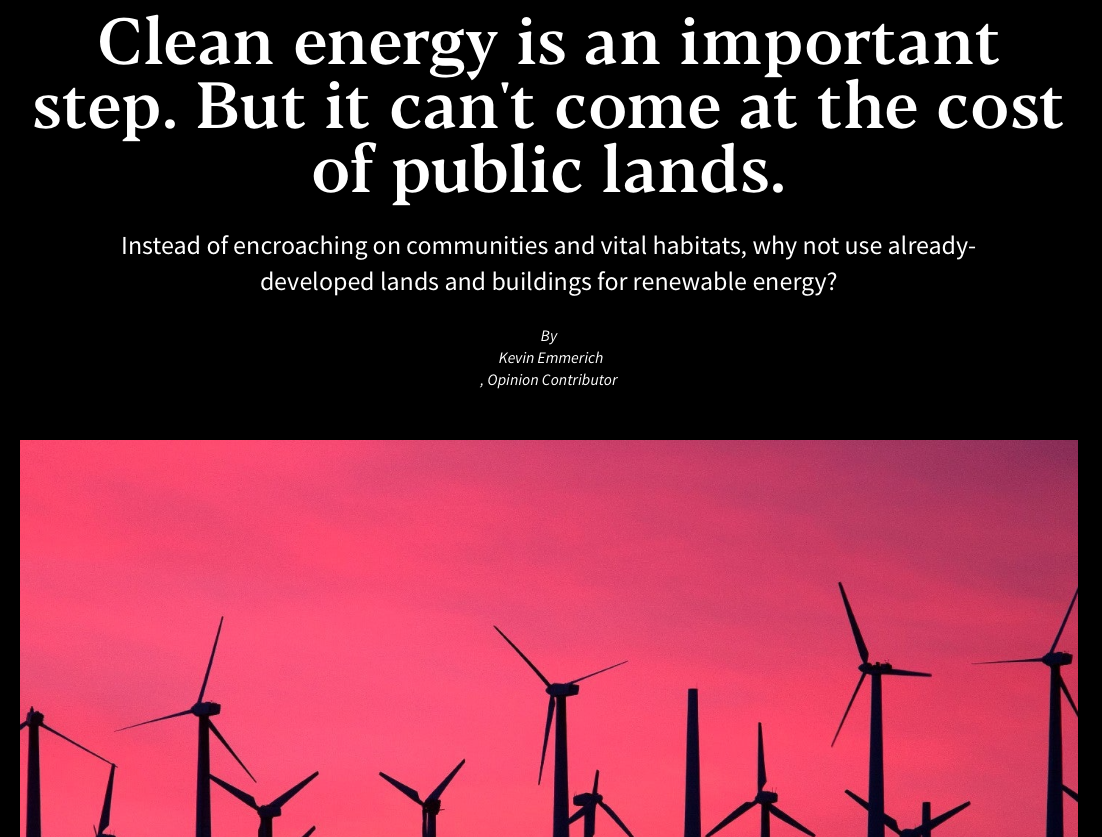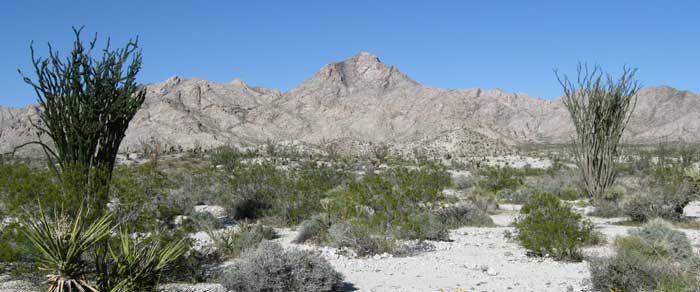
By Kevin Emmerich, Opinion Contributor to The Hill.
February 9, 2021.
President Biden's executive order to "restore balance on public lands and waters, invest in a clean energy future" makes positive steps towards long-term conservation goals. But the order allows too much public land to be sacrificed for renewable energy development.
Large-scale renewable energy requires the use of thousands of acres just to build one project. The order identifies the impacts that oil and gas development has had on public lands but fails to acknowledge the impacts that large-scale green energy projects have had on public lands in the last decade. Making the transition from fossil fuel to carbon-free energy is an important step to confront climate change, but our built environment should be used before so much of our cherished public lands are turned over to energy developers.
In 2008, President Obama made an aggressive move to transform energy infrastructure in the western U.S. to renewable energy. One of those strategies was to expedite or "fast-track” the approval of renewable energy on public lands. The administration made efforts to streamline environmental review for some of these projects and developed a loan guarantee program that provided tens of billions of dollars up front to some large-scale renewable developers. Several large renewable energy projects were built which required about 2,000 to 10,000 acres of land. For perspective, one solar project could be as large as 900 combined football fields, or some small cities. Wind energy projects were built in migratory bird flyways.
Unfortunately, this has resulted in major environmental impacts. These projects have impacted habitat for endangered species, killed wildlife, used up groundwater, impacted national parks and wilderness areas and have destroyed important archeological sites.
In addition, Native American tribes, rural low-income communities, communities of color, and underserved communities have often had to take the brunt of industrial solar and wind development on public lands adjacent to private parcels.
A few examples would be:
Very large utility-solar projects located near Blythe, California, were strongly opposed by Native American Tribes because they destroyed important traditional sites and cultural landscapes.
Solar projects in Nevada and California have removed thousands of acres of habitat for the federally threatened desert tortoise which is declining in numbers throughout the Mojave Desert. The tortoise continues to decline range-wide and may need increased protection.
Large-scale solar projects have killed large numbers of birds. Large solar projects are believed to mimic lakes and bird collision mortalities have been found in the solar fields. Solar thermal “power towers” concentrate heat and energy on a central tower and create a lethal “solar flux” which can incinerate birds in midair.
Many of these projects have been built next to popular National Parks and Wilderness Areas. The projects are so large that views from conservation areas are degraded. This can have negative impacts on tourism economies in smaller communities located near these areas.
Healthy functioning desert and arid grassland ecosystems that have been developed for large-scale energy are considered carbon sinks. Deserts have old plants and ancient biological soil crusts that hold carbon. A study in the journal Nature Geoscience found that closed basins in deserts — areas into which water flows on but doesn’t flow out — are significant storehouses of carbon, but their ability to act as carbon sinks may diminish as they are developed.
Local communities and small towns in the desert have often opposed adjacent utility-scale solar and wind projects that alter the scenery and industrialize remote areas which impact quality of life.
Congress slipped the Public Lands Renewable Energy Development Act into the most recent COVID-19 Relief Bill. The measure was signed into law and now requires by 2025 an increase of at least five times the amount of solar, wind and geothermal energy production currently on federal land.
Why not use previously developed lands as well as existing buildings for renewable energy?
Energy is more equitable when it is locally owned and locally generated. Using the energy on a smaller distributed scale reduces the need to bulldoze remote wildlands. Distributed energy also lessens the need for the build-out of high-voltage transmission infrastructure. Many of the tragic California mega-fires that have claimed hundreds of lives were started by failing transmission lines. Rooftops of both private homes and business provide great potential to utilize solar energy. The energy can go directly to the user while excess peak generation can be stored in batteries to be sold back to local microgrids with net-metering programs. A study by the National Renewable Energy Laboratory has determined that California alone could generate 74 percent of its energy from rooftop solar. In 2020, the country of Vietnam installed 9 gigawatts of solar on rooftops.
Our public lands are an American legacy that become more valuable each year as our population increases. With smart planning, we can make the transition off fossil fuel without sacrificing large units of public lands for energy development.
Kevin Emmerich is a former ranger for the National Park Service and has also worked as a biologist on surveys for rare and endangered species in the Mojave Desert. He is now the Co-Founder of Basin and Range Watch, a non-profit working to conserve the deserts of Nevada and California and to educate the public about the diversity of life, culture, and history of the ecosystems and wild lands of the desert.

^Chemehuevi Mountains framed by Ocotillos, California Desert.
